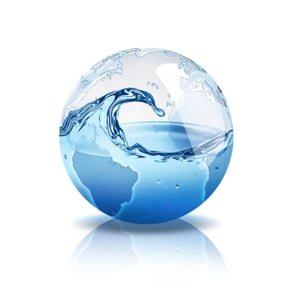About 71% of the surface of Earth is covered in water, yet our water resources are quickly dwindling. How is this scarcity possible when there is so much water? The first step to understanding is knowing where that water is.
Where the Water Is
Of all the water on the planet, the vast majority of it — a massive 96% — is saline and too salty for any human uses.
That leaves about 4% of the Earth’s water, around 2,551,000 cubic miles of it, as fresh water fit for human use. One cubic mile of water is the equivalent of more than 1 trillion gallons.
Of that volume, as much as 68% is unavailable to us, locked up in glaciers, permafrost, and other ice formations.
Another 30% of freshwater is groundwater, stored within soil, rock formations, and underground aquifers. Some groundwater is accessible, but well drilling is required.
The remainder of the water on Earth is surface water, found in swamps, rivers, and lakes. This water accounts for only 0.008% of the total amount of water.
Rivers, the number one source of fresh water withdrawn for human use, only contain about 300 m3, or .0002% of the water found on the planet.
Where the Water Goes
Freshwater withdrawals can be separated into three primary categories:
- Agriculture — including irrigation, livestock, and aquaculture
- Industrial — including electricity generation and industrial processes
- Domestic/Public Use — including drinking water, plumbing, bathing, and more
According to the United States Geological Survey (USGC), in 2010 the United States alone withdrew 306,000,000,000 gallons of water a day. Total US withdrawals for the year were about 111,690,000,000,000 (about 111 m3).
Only 11% of those withdrawals were from groundwater sources — the rest were from surface water sources.
Agricultural applications are the single largest use of freshwater in the country, utilizing as much as 80% of all annual freshwater withdrawals. Crop irrigation alone accounted for 38% of the United States’ withdrawals in 2010.
Industrial processes, including power generation, follow agriculture as the second largest user of water withdrawals. Highly industrialized nations can use upwards of half of total water withdrawals for industry purposes.
After agriculture and industry, the remainder of freshwater withdrawals go to domestic uses, standard around-the-house activities such as drinking and bathing. In the United States in 2010, this amounted to around 14%.
What Happens Without Water
Global freshwater withdrawals are rising rapidly as urbanization, electricity requirements, and large-scale agriculture all grow. Without dedicated water conservation efforts, Earth’s supply of clean, usable fresh water will run out.
As water becomes scarcer, even disappearing completely from drier locales, populations will be forced to migrate because of drought. Influxes of water refugees will cause tensions and, according to the UN, conflict is all but inevitable.
As rivers and swamps shrink and dry up, the ecosystems they support will crumble, leading to unknown environmental impacts.
Without freshwater for irrigation, agriculture will begin to collapse. In the absence of surface water, farmers can turn to groundwater reserves — but those are finite as well. Areas like California’s Central Valley, one of the largest agricultural areas in the United States, will become barren and result in widespread food shortages.
This is just the tip of the iceberg. Without a proper supply of freshwater, the ramifications will be severe and widespread.
Learn More
To learn about important water conservation steps that can be put into action today, download AM Conservation Group’s free Water Conservation Checklist today.





